If you’re aiming to bring in traffic through your content, it’s tempting to dive straight into cranking out articles around the most popular keywords.
But unless your site is already seen as a heavyweight in the industry and you’ve got a rock-solid, long-term SEO strategy with a proven track record, this approach could feel like pushing a boulder uphill.
No joke. Going after those high-competition short-tail keywords could have you spinning your wheels for ages—and you might never snag them.
Instead, try targeting what’s known as “low-hanging fruit keywords” to start pulling in traffic right away. It’s a smart way to build momentum before tackling those tougher keywords.
In this guide, we’ll discuss the steps to find low hanging fruit keywords and effectively target them, allowing you to boost your SEO efforts with less effort and quicker results.
What are Low Hanging Fruit Keywords?
Low-hanging fruit keywords are search terms with less competition compared to the more common ‘head’ keywords often targeted by SEO experts. Even though they’re easier to rank for, these keywords still bring valuable traffic and opportunities. Typically, low-hanging fruit keywords have lower difficulty but still offer enough search volume to make them worth targeting.
Here’s an example:
Let’s say I run an ecommerce store selling running shoes. I might want to rank for the keyword “running shoes,” but as you can imagine, that’s a tough one:
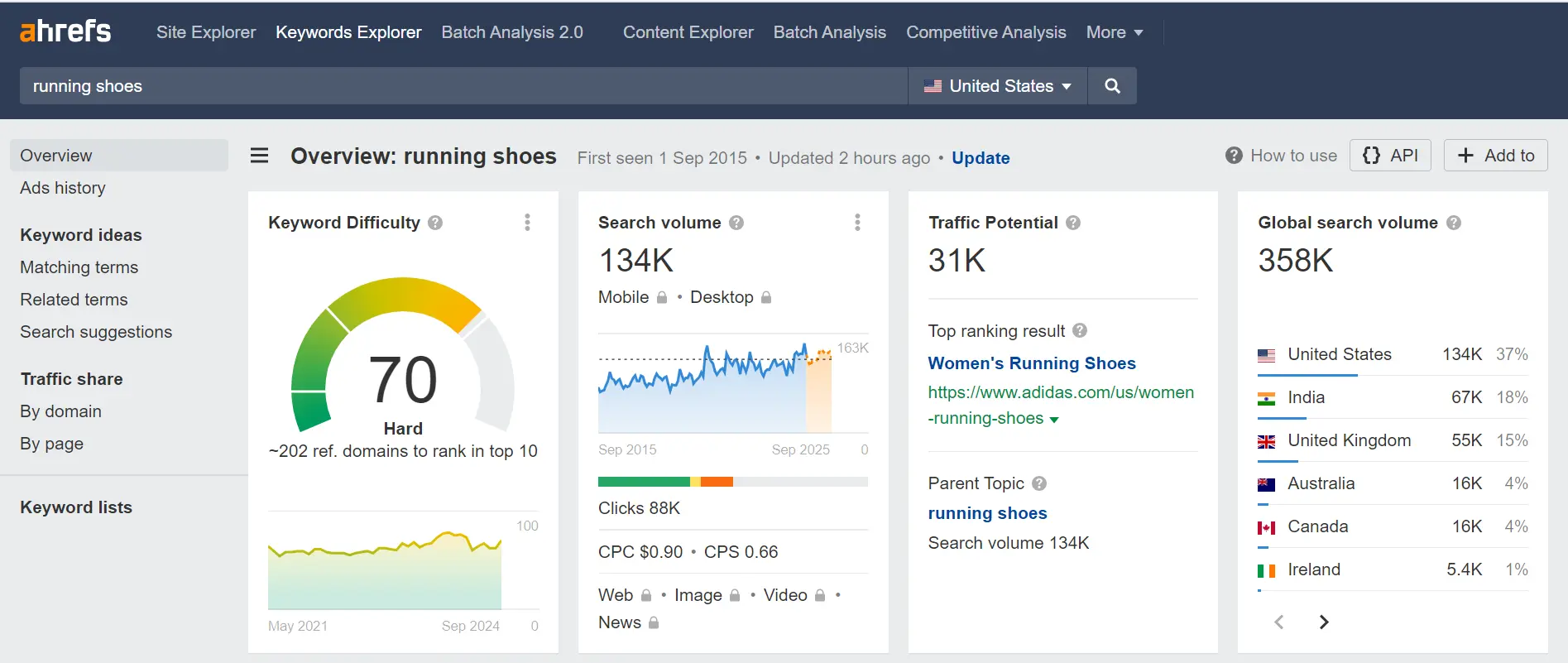
As shown, “running shoes” has a high keyword difficulty of 70, which means I’d need a ton of top-notch, relevant backlinks to stand a chance of ranking well. Plus, my page would need a high authority level to crack the top ten results:
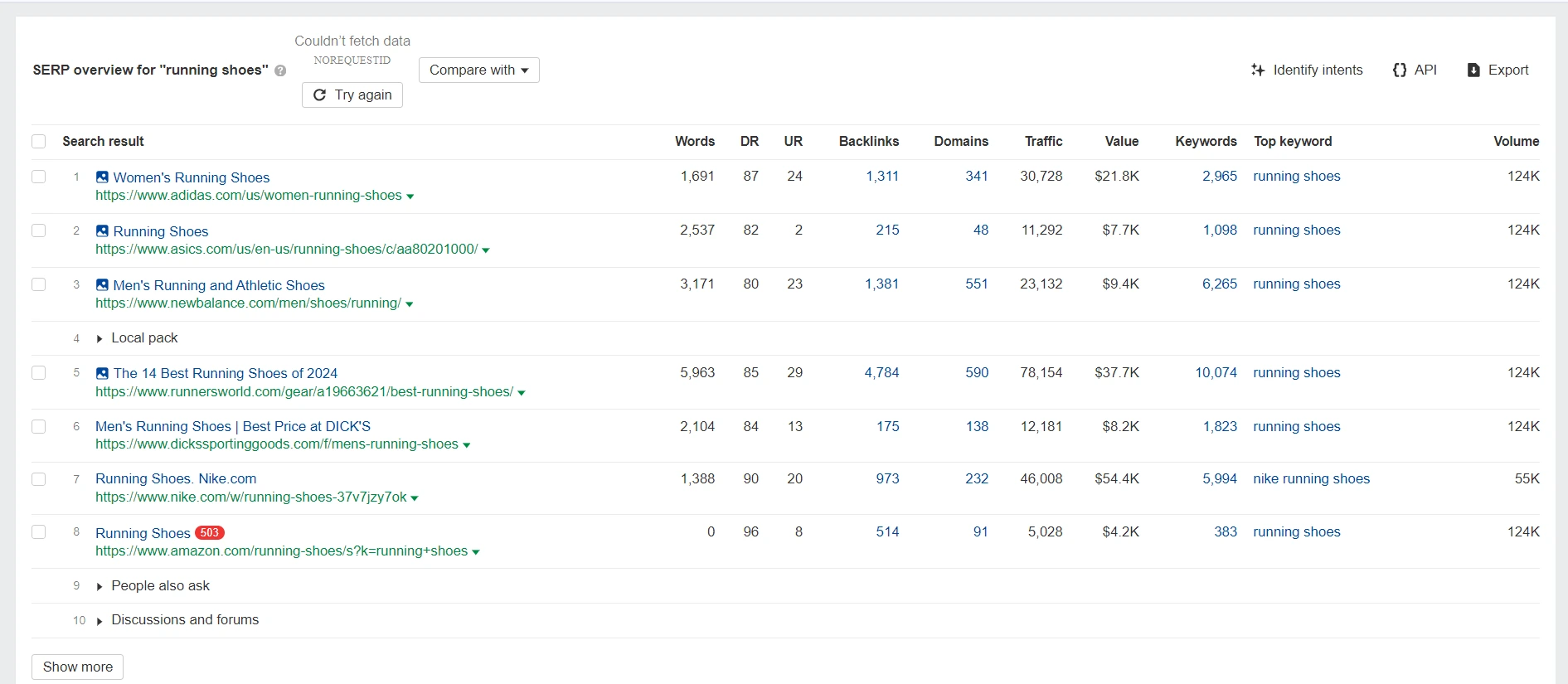
But there’s a smarter play. I can go after keywords that are still valuable to my business but much easier to target with strong content and some well-placed backlinks. I can target keywords like “marathon running shoes.” The keyword difficulty is 6, which means it is easier to rank.

This keyword has lower difficulty, giving us a solid shot at ranking in the top ten with fewer backlinks required.
By focusing on a more specific keyword, I make my job easier and still reach plenty of potential customers. “Marathon running shoes” is a perfect example of a low-hanging fruit keyword.
What are the Benefits of Utilizing a Low-Hanging Fruit Keywords Strategy?
Focusing on low-hanging fruit keywords in your SEO strategy can bring some pretty clear benefits. Let’s take a closer look at why these keywords are worth your time.
1. Quick Wins
Think of low-hanging fruit keywords as your shortcut to success. Instead of sweating it out for months trying to rank for something tough like “running shoes,” you can score quicker wins by focusing on more specific, less competitive keywords. For example:
- Marathon Running Shoes
- best marathon running shoes
- best running shoes for marathon
- Half Marathon Running Shoes
- 10km Running Shoes
- 5km Running Shoes
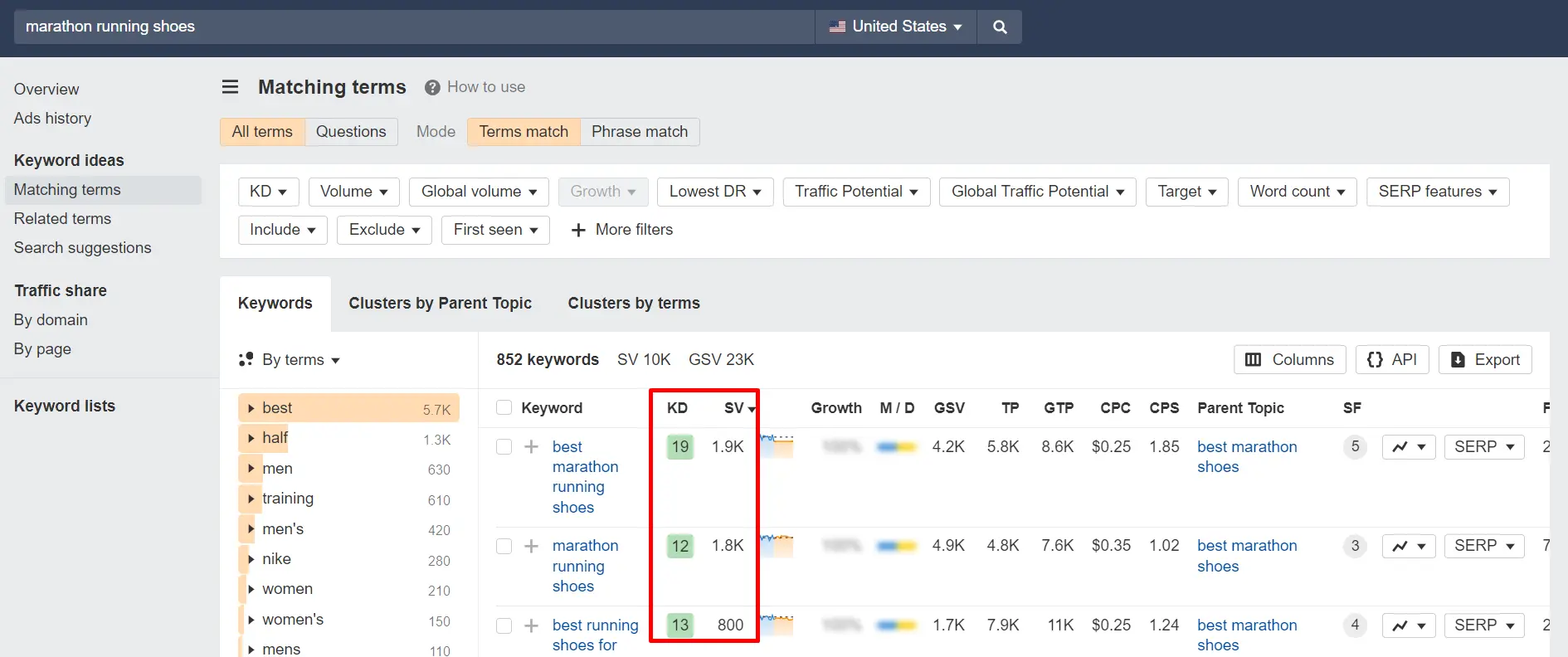
These are easier to rank for, need fewer backlinks, and get you visible in search results faster. Sure, the traffic might be lower, but it’s more targeted—meaning the people who do find you are more likely to be ready to buy.
2. Save Some Cash
Targeting low-hanging fruit keywords is also easier on your wallet. We all know buying links is off-limits, according to Google, and even when you’re building links the right way, it can still get pricey.
You’ve got to invest in:
- Creating top-notch content
- Using tools for research and outreach
- Hiring people who know how to build and get the right links
With these easier-to-rank keywords, you won’t need to shell out as much cash. This is why smaller businesses and agencies often start here — it’s a budget-friendly way to get results.
3. Win Over the Bosses
Starting with low-hanging fruit keywords is a great way to show progress fast. When your boss or clients see that traffic is going up and your efforts are paying off, they’re more likely to give you the green light (and budget) to keep going. It’s a confidence booster for everyone involved.
4. Build Up Your Street Cred
In SEO, more traffic and backlinks usually mean more authority. Low-hanging fruit keywords help you build that authority faster because they’re easier to rank for. As your site starts getting more traffic and backlinks, it becomes easier to go after those bigger, more competitive keywords down the road.
5. Get That Traffic Rolling
If your site is new and doesn’t have much traffic or authority, low-hanging fruit keywords are your best bet for getting things moving. Instead of trying to rank for broad terms right away, go after specific keywords that still get decent searches.
For instance, keywords like:
- brooks running shoes women
- hoka trail running shoes
- brooks running shoes men
- brooks womens running shoes
- brooks ghost running shoes
- new balance trail running shoes

These keywords have lower difficulty (under 20) but still attract a decent amount of monthly searches (between 1,000 and 10,000). This gives you a solid chance to create product pages, rank for these terms, and start driving traffic to your site quickly.
6. Keep Visitors Engaged
When you target low-hanging fruit keywords, you’re often aligning with exactly what your potential customers are searching for. This means they’re more likely to stick around, explore your site, and eventually make a purchase. For instance, someone searching for “best running shoes for flat feet” is more likely to buy than someone just browsing for “running shoes.”
7. Play It Safe
Going after low-hanging fruit keywords is a safer bet. You’re not throwing all your resources at highly competitive terms where the outcome is uncertain. Instead, you’re focusing on keywords that are easier to rank for and more likely to bring you quick, tangible results. This way, you attract the right kind of traffic without burning through your budget or time.
How to Find Low Hanging Fruit Keywords Using Google Search Console?
Google Search Console provides valuable data that can help you identify low-hanging fruit keywords with ease. This tool offers insights into the search terms that are already bringing traffic to your site, many of which might be untapped opportunities for growth.
Here’s how you can use Google Search Console to discover and target these useful keywords:
Once you’re in, click on the ‘performance’ tab. This will show you a dashboard with your total clicks, impressions, average click-through rate, and average search position.
Next, head over to the ‘pages’ tab and pick the page you want to dig into. After that, when you go back to ‘queries,’ you’ll see the performance data narrowed down to that specific page. This will give you a list of keywords people used to find that page, along with the clicks and impressions each keyword generated.
Focus on the keywords ranked between 6 and 15, which usually land on Google’s second page. These keywords are often the easiest to boost and push onto the first page.
When choosing the best keywords, start with impressions—this shows how often your result shows up for a certain phrase. You can click on the ‘impressions’ tab to sort and see which keywords are getting the most visibility.
The next thing to consider is commercial intent—how likely it is that a keyword will lead to a sale. For example, ‘buy DIY supplies online’ is more likely to result in a purchase than ‘free DIY tips.’ So, pick keywords that fit your business goals.
Finally, export your data to Google Sheets and sort the keywords into low, medium, and high priority based on these criteria. Now you’re ready to put them to use!
Tip: Once you’ve found those low-hanging fruit keywords, it’s time to tweak your content. You can either freshen up what’s already there or whip up something new that directly targets those keywords.
Look at your title tags, headings, and meta descriptions—give them a quick update to align with the keywords you’re aiming for.
Also, consider adding a few new sections to your content that hit those keywords hard. This simple approach can help your site climb the rankings and bring in more organic traffic without too much hassle.
How to Find Low Hanging Fruit Keywords Using Semrush?
When it comes to improving your website’s visibility, sometimes the smartest move is to go after the opportunities that are right within reach. Semrush is a fantastic tool for uncovering these quick-win keywords that can elevate your rankings with minimal effort. In this guide, we’ll show you how to use Semrush to identify and capitalize on those valuable keywords that can give your site an immediate boost.
1. Finding Long Hanging Fruit Keywords from Current Website Performance
Finding those easy-win keywords with Semrush is pretty straightforward. Here’s how you can do it:
Step 1: Jump into the Organic Research Tool
Start by opening the Organic Research tool in Semrush. Enter your website’s URL in the search bar, and let it pull up all the keywords your site is ranking for. This is your starting point to identify opportunities.
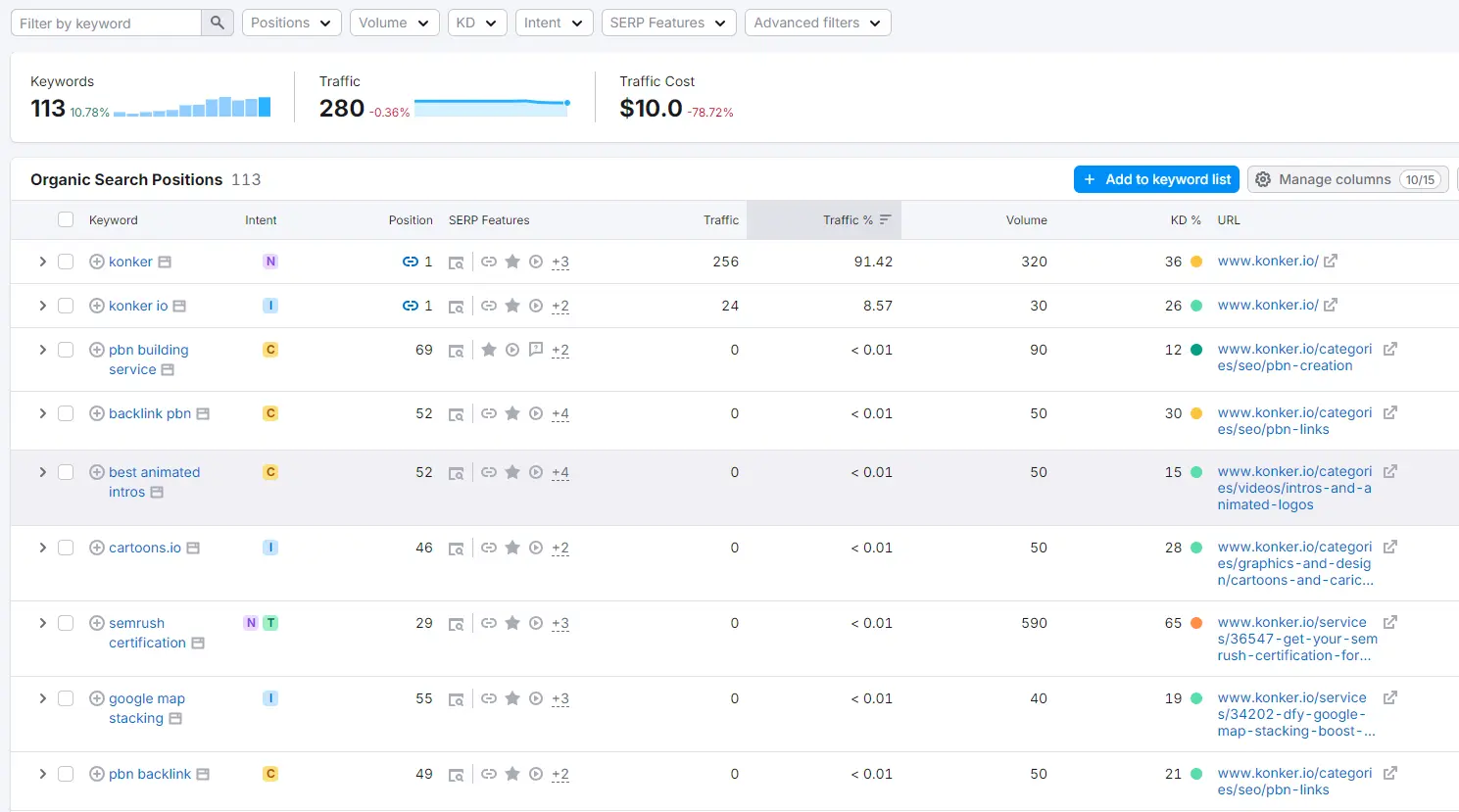
Step 2: Look for Keywords with Good Impressions but So-So Positions
Once you’ve got your list, sort it by position. Focus on keywords sitting in positions 11-20—these are on the brink of breaking into the top 10 but need a little nudge.
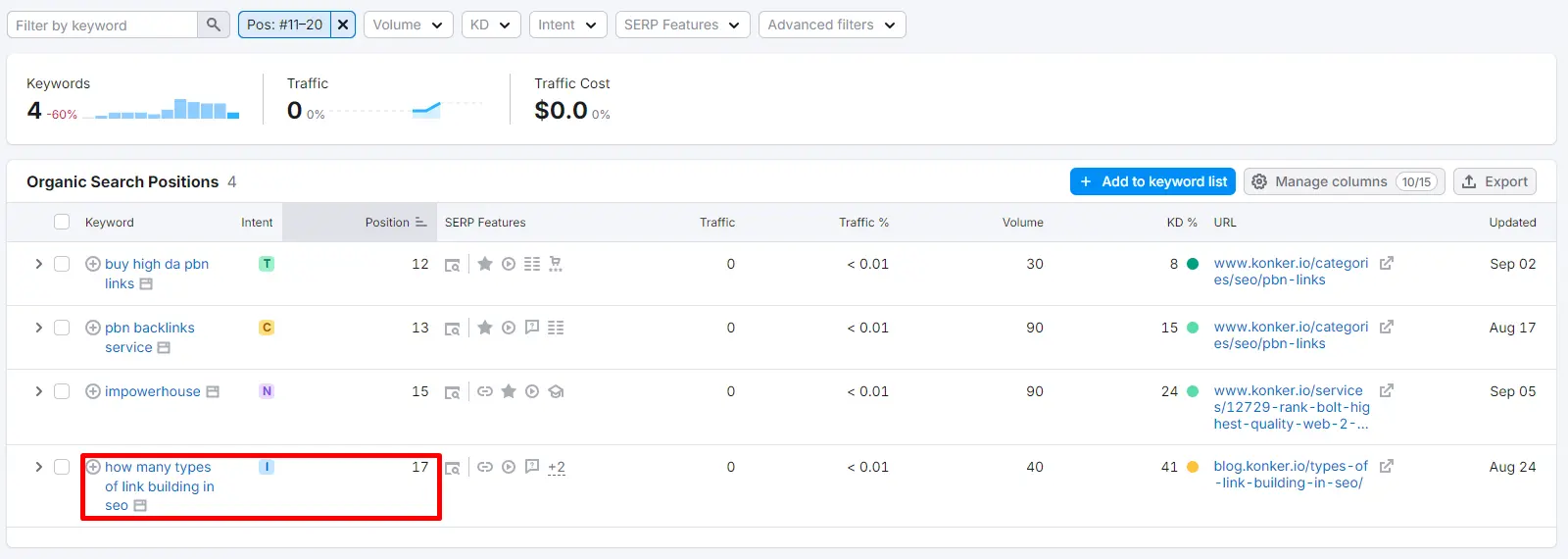
For instance, if you see “how many types of link building in seo” ranking at position 17, that’s your low-hanging fruit. It’s already driving some traffic, and with a bit of effort, you can get it to climb higher and attract even more visitors.
Step 3: Check Out the Competition
Check the performance of the low-hanging fruit keywords to see who’s outranking you. Analyze what the top-ranking sites are doing differently. Are their posts longer, more detailed, or loaded with images? Do they have a killer headline or more backlinks?
For example, if a competitor’s article on “quick healthy meals” is more comprehensive or has better visuals, that’s your clue to up your game. Take notes and figure out how to improve your content.
Step 4: Update Your Content
Armed with your competitive insights, go back to your content and make some tweaks. Maybe add a couple of subheadings, enhance your introduction, or include a video or infographic.
Let’s say your article on “easy vegan recipes” is 800 words, but the top result is 1,500 words with more examples. Consider expanding your post with additional recipes or tips. These small updates can give your content the boost it needs to rank higher.
Step 5: Monitor and Repeat
Keep an eye on how your updates impact your rankings. Semrush has tracking tools to help with this. If you notice your “quick healthy meals” keyword moving up, that’s a win! If not, don’t sweat it—try another approach or adjust your strategy. Maybe add internal links to related articles or refresh your meta descriptions. The key is to stay flexible and keep refining your content based on what’s working.
By following these steps and using Semrush to its full potential, you can easily spot those low-hanging fruit keywords that can drive more traffic to your site. It’s all about making small, strategic adjustments that lead to big gains over time.
2. Finding New Long Hanging Fruit Keywords From Scratch
If you’re starting fresh or exploring new keyword opportunities, here’s how you can use Semrush to find low-hanging fruit keywords:
Step 1: Fire Up the Keyword Magic Tool
Begin by opening the Keyword Magic Tool in Semrush. Enter a broad keyword related to your industry or niche, like “digital marketing”. This tool will generate a massive list of related keywords that you can start exploring. For example, if you enter “digital marketing,” you might see related keywords like “digital marketing agency,” “what is digital marketing,” or “digital marketing tools.”
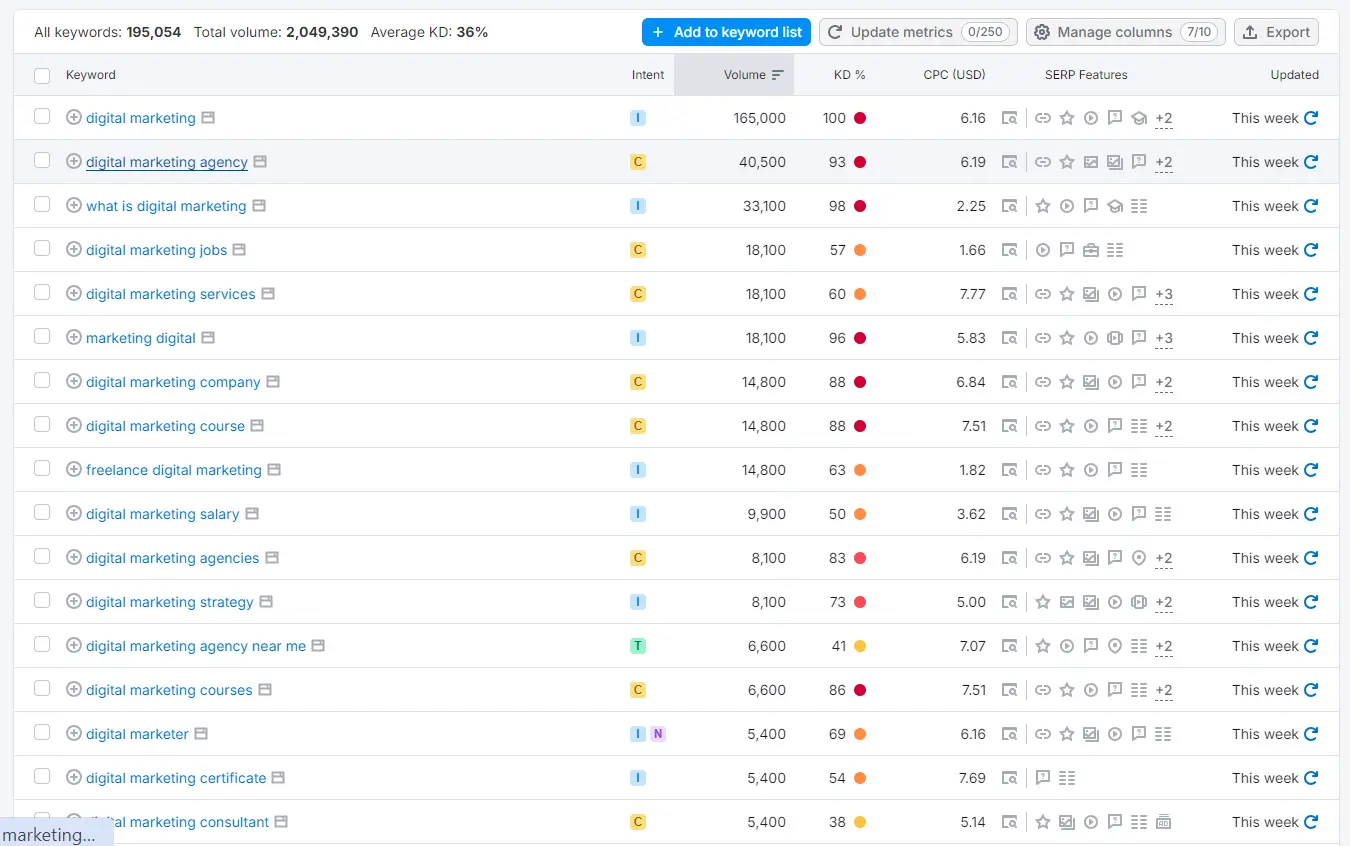
Step 2: Filter by Keyword Difficulty
Once you have your list, use the filters to narrow it down. Set the keyword difficulty to a range that’s realistic—typically, anything under 60 is a good starting point for most sites. Lower difficulty means less competition, making it easier for you to rank.
For instance, instead of targeting a competitive term like “digital marketing agency,” you might focus on something more specific like “digital marketing services” or “digital marketing near me” with a difficulty score of 60 and 40 respectively.
Step 3: Sort by Search Volume
After filtering by difficulty, sort the keywords by search volume. Focus on keywords that have a decent number of searches but aren’t too competitive.
Step 4: Check Out Long-Tail Keywords
Don’t overlook long-tail keywords, which are longer phrases that typically have lower competition. While they may have less search volume, they often attract more targeted traffic.
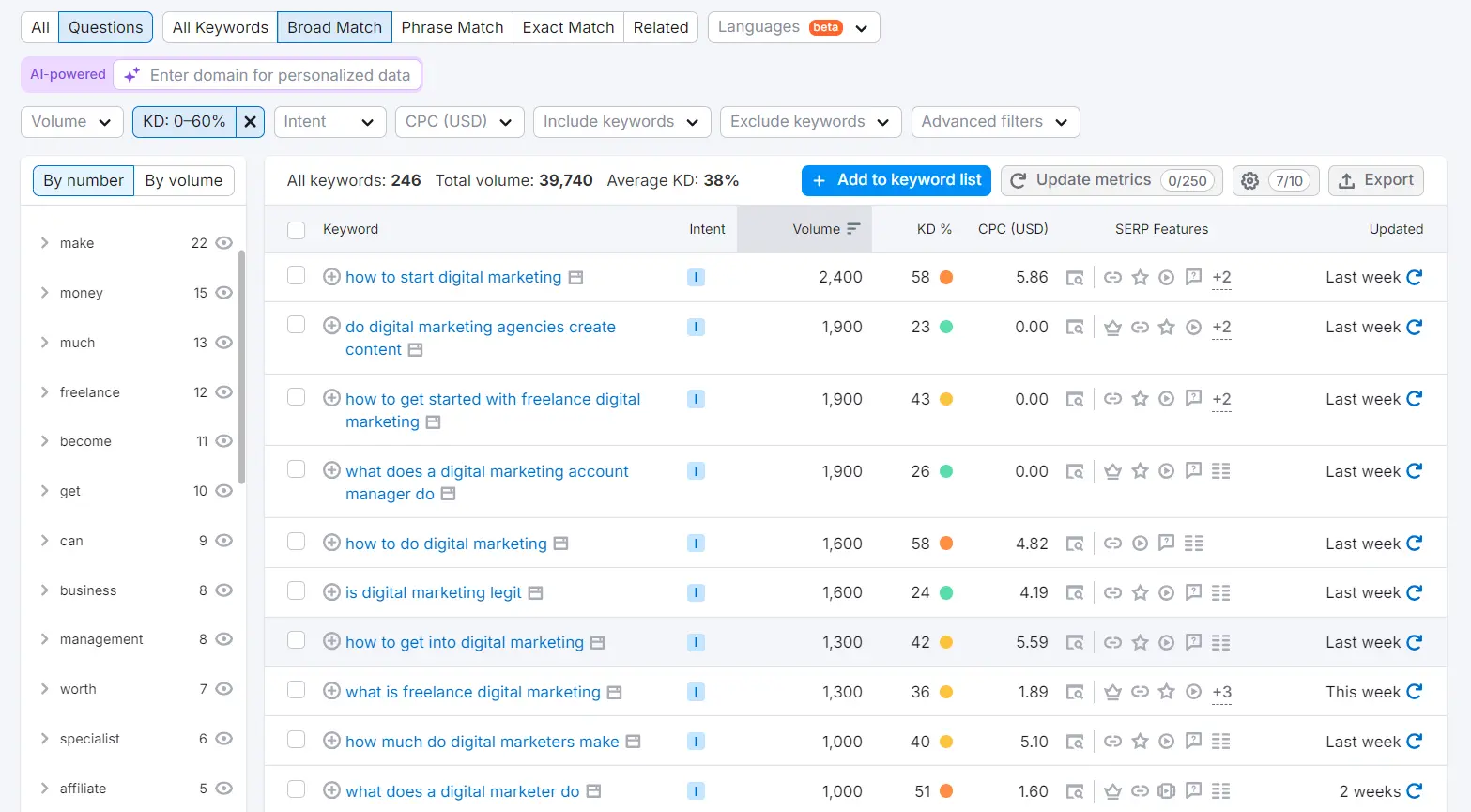
For example, instead of “digital marketing,” a long-tail keyword might be “what is freelance digital marketing” or “How to start digital marketing.” These keywords are easier to rank for and can still drive significant traffic, especially if your content directly addresses the specific query.
Step 5: Analyze the SERP Features
For the keywords you’re interested in, take a quick look at the SERP (Search Engine Results Page) features. Check if big brands dominate the top results or if there’s room for you to compete. If you see results from smaller blogs or niche websites, that’s a good sign you can rank as well. For example, if you find a keyword like “best hiking gear for beginners” and the top results are from lesser-known sites, you’ve likely found a keyword with lower competition.
Step 6: Make Your Keyword List
After identifying your low-hanging fruit keywords, organize them into a list. Group similar keywords together by theme or topic. For instance, if you’re targeting keywords related to “digital marketing,” you might group them into categories like “SEO tips,” “content marketing strategies,” and “social media marketing.” This will help you create content that targets multiple related keywords, maximizing your SEO efforts.
How to Find Low Hanging Fruit Keywords Using Ahrefs?
If you’re looking to boost your site’s search engine rankings without spending countless hours, Ahrefs is your go-to tool. With its powerful features, you can quickly identify keywords that offer the best opportunities for improvement. Here is a step by step guide on how to use Ahrefs to uncover those low-hanging fruit keywords that can help you achieve quick and effective SEO wins.
1. Finding Long Hanging Fruit Keywords from Current Website Performance
Finding low-hanging fruit keywords with Ahrefs is a breeze if you know where to look. Here’s a simple breakdown:
Step 1: Jump into the Site Explorer
Start by entering your website’s URL into Ahrefs’ Site Explorer. This tool shows you everything you need to know about your site’s performance, including which keywords you’re already ranking for. For example, if you run a blog about building links, you might discover that your site ranks for terms like “backlinks service” or “buy pbn backlinks.”
Step 2: Check Out the Organic Keywords Report
After you’re in the Site Explorer, head over to the Organic Keywords report. This is where you’ll find all the keywords your site ranks for, along with their positions, search volume, and potential traffic. Imagine you see that “pbn backlinks service” is ranked 15th—it’s close to the first page, but not quite there yet. So, you should pick this keyword to work on and optimize it.

Step 3: Look for Keywords in Positions 8-20
Sort the list by position and focus on keywords sitting in positions 8-20. These are your low-hanging fruit—they’re already ranking but need a little push to reach the top. For example, if “purchase pbn links” is ranking 18th, it’s just waiting for some attention to break into the top 10.

Step 4: Filter by Search Volume
To avoid wasting time on keywords that no one’s searching for, use the search volume filter. You might set it to show keywords with at least 500 monthly searches. This way, you’re focusing on terms that can drive meaningful traffic, like “backlinks service” with 800 monthly searches.
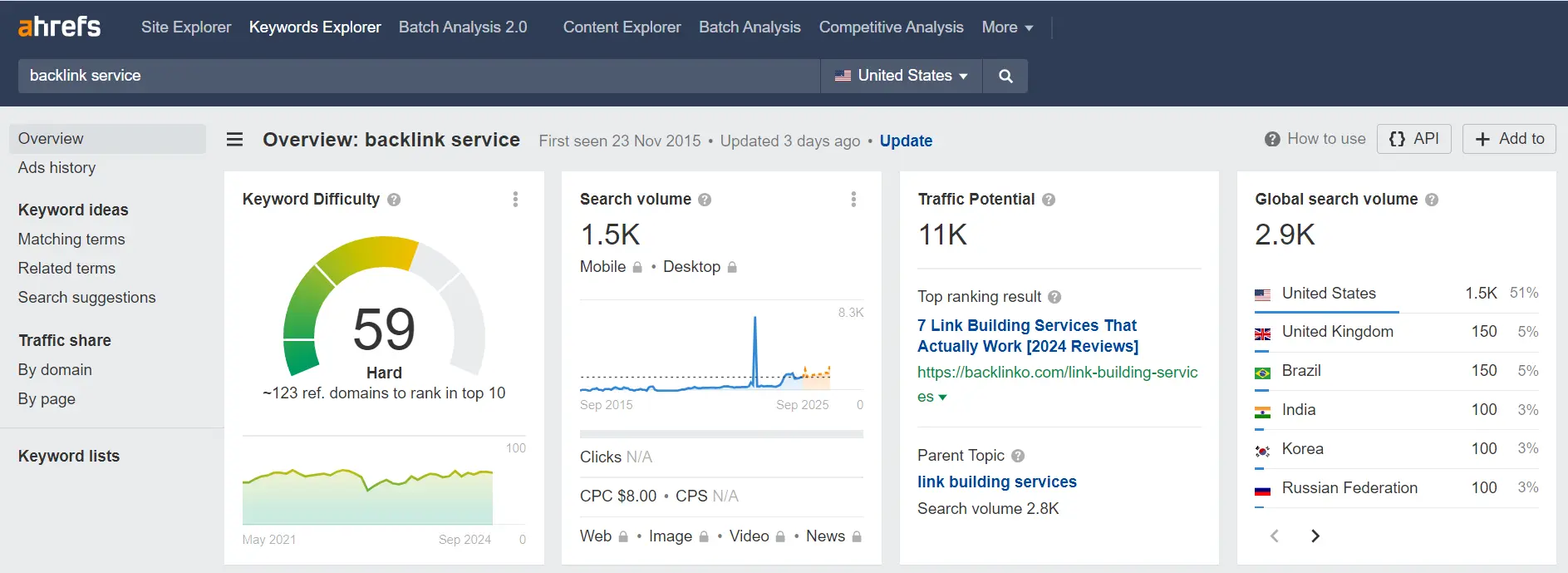
Step 5: Spy on the Competition
Ahrefs lets you see who’s currently ranking for these keywords. Check out what your competitors are doing—maybe their content is missing something you can add. For instance, if your competitor ranks higher for “seo backlinks services,” but they don’t mention low-light options, you can fill that gap in your content.
Step 6: Fine-Tune Your Content
Once you’ve identified your low-hanging fruit keywords, it’s time to polish your content. Revisit your titles, headings, and meta descriptions to include these keywords naturally. If your blog post on “link building” is a bit thin, consider adding a section on common mistakes or a detailed section on “how to do link building.” These tweaks can help your content climb the rankings and draw in more traffic.
With Ahrefs, finding and targeting low-hanging fruit keywords is simple and effective. By focusing on these easily achievable wins, you can boost your site’s visibility and grow your organic traffic without needing to overhaul everything.
7. Broken Link Building
If you’re searching for fresh, easy-to-rank keywords that haven’t yet been tapped, Ahrefs is a powerful tool. Here’s a simple way to find those new low-hanging fruit keywords:
Step 1: Use the Keyword Explorer
Start by going to Ahrefs’ Keyword Explorer tool. Enter a broad term related to your niche. For instance, if you’re selling running shoes, you might enter “running shoes” or “best running shoes.” The Keyword Explorer will return a list of related keywords, along with details like search volume, keyword difficulty, and more.
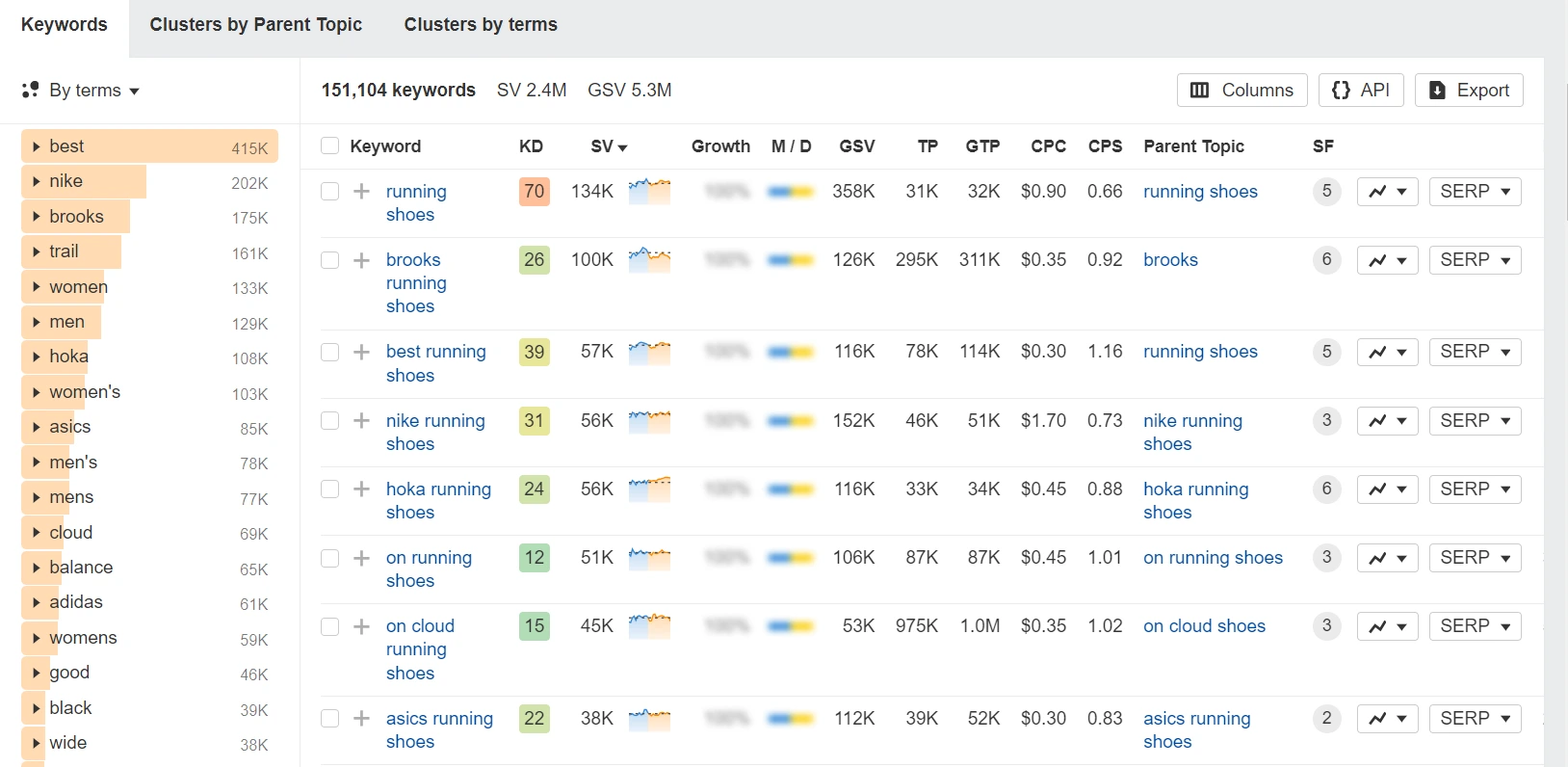
Step 2: Look for Keywords with Low Difficulty
Once you get the results, sort the list by keyword difficulty (KD). Focus on keywords with a low KD score, typically under 20. These are your low-hanging fruit—keywords that are easier to rank for because they have less competition. For example, you might find “best trail running shoes” or “adidas running shoes” with a KD of 12 or lower.

Step 3: Filter by Search Volume
While low difficulty is great, you also want keywords that people are actually searching for. Apply a filter to show keywords with a decent search volume, like at least 300 monthly searches. This way, you’re focusing on keywords that can drive traffic. For example, “running shoes for flat feet” might have 800 searches per month with a KD of 12, making it a perfect target.
Step 4: Explore Related Keywords
Ahrefs also suggests related keywords that you might not have considered. Use the “Phrase Match” or “Questions” filters to find variations or long-tail keywords that are easy to rank for. For example, under “running shoes,” you might find “best running shoes for rainy weather” or “running shoes for knee pain” with low competition.
Step 5: Check Out the SERP Overview
For each keyword, Ahrefs gives you a snapshot of the top-ranking pages in the SERP (Search Engine Results Page). Look at these pages to gauge the competition. If the top results are from smaller sites or have basic content, you have a good shot at ranking higher by creating more detailed, helpful content.
For instance, if the top result for “best running shoes for beginners” is a short listicle, you could create a more comprehensive guide with detailed reviews, pros, and cons.
Step 6: Create Content Around New Keywords
Once you’ve zeroed in on your new low-hanging fruit keywords, it’s time to craft content. Build blog posts, guides, or videos that directly target these keywords. Make sure your content is thorough, answers common questions, and offers value.
For example, if you’re targeting “running shoes for flat feet,” you could create a blog post that explains why specific shoes are better for flat feet, backed by customer reviews and expert tips.
How To Optimize For Low-hanging Keywords
Optimizing content for low-hanging keywords is like picking ripe fruit—easy wins that can bring sweet results. Here’s how to go about it without getting too technical:
1. Find the Keywords That Are Almost There
Dive into Google Search Console and check which keywords you’re already ranking for, but not quite at the top. These are your low-hanging fruit. Focus on the ones hanging out on page 2 or 3—they’re the easiest to bump up with a little attention.
2. Polish Up What You Already Have
Take a look at your existing content that’s close to ranking well. Add some fresh insights, beef up the details, and make sure the low-hanging keywords are naturally included. Sometimes just tweaking a headline or adding a new section can make all the difference.
3. Link to Boost Rankings
Don’t leave your pages stranded. Use internal links to connect your optimized content with other strong pages on your site. This helps search engines see its value and can give you a ranking boost.
4. Keep It Updated
Content isn’t “set it and forget it.” Keep it fresh by updating stats, adding new examples, or refining the message. Regular updates show search engines that your content is still relevant, which can help improve its ranking.
5. Check Your Progress
After making changes, monitor your rankings. If your content isn’t moving up, don’t be afraid to tweak it again. SEO is a game of patience and adjustments, so keep refining until you see results.
6. Focus on Speed
Nobody likes a slow website, not even Google. Ensure your content loads quickly, especially on mobile devices. Compress images, clean up code, and use a fast hosting service. Speed matters more than you think for ranking.
By expanding your approach and covering these additional bases, you’ll maximize your chances of climbing the rankings with minimal effort. Optimizing for low-hanging keywords is all about making smart moves that get results without reinventing the wheel.
Conclusion
Targeting low-hanging fruit keywords is a smart move for businesses looking to get the most out of their SEO efforts. By focusing on these less competitive but still valuable keywords, you can score quick wins, save on costs, and build confidence among stakeholders. It’s a great way to grow your authority and traffic organically, even if you’re working with a tight budget.
Zeroing in on low-hanging fruit keywords also boosts user engagement and minimizes risk, making it a solid strategy for both new and established sites. Tools like Google Search Console, SEOTesting, and Ahrefs are handy for spotting these opportunities, helping you create content that draws in the right audience and drives conversions.
The goal isn’t just about grabbing quick wins; it’s about setting up a strong foundation for long-term SEO growth. By starting with these easier targets, you’re setting the stage for bigger wins down the line, eventually taking on more competitive keywords as your authority and traffic grow.








It’s very trouble-free to find out any topic on net as compared to textbooks, as I found
this piece of writing at this site.